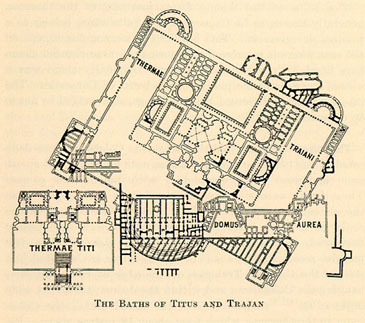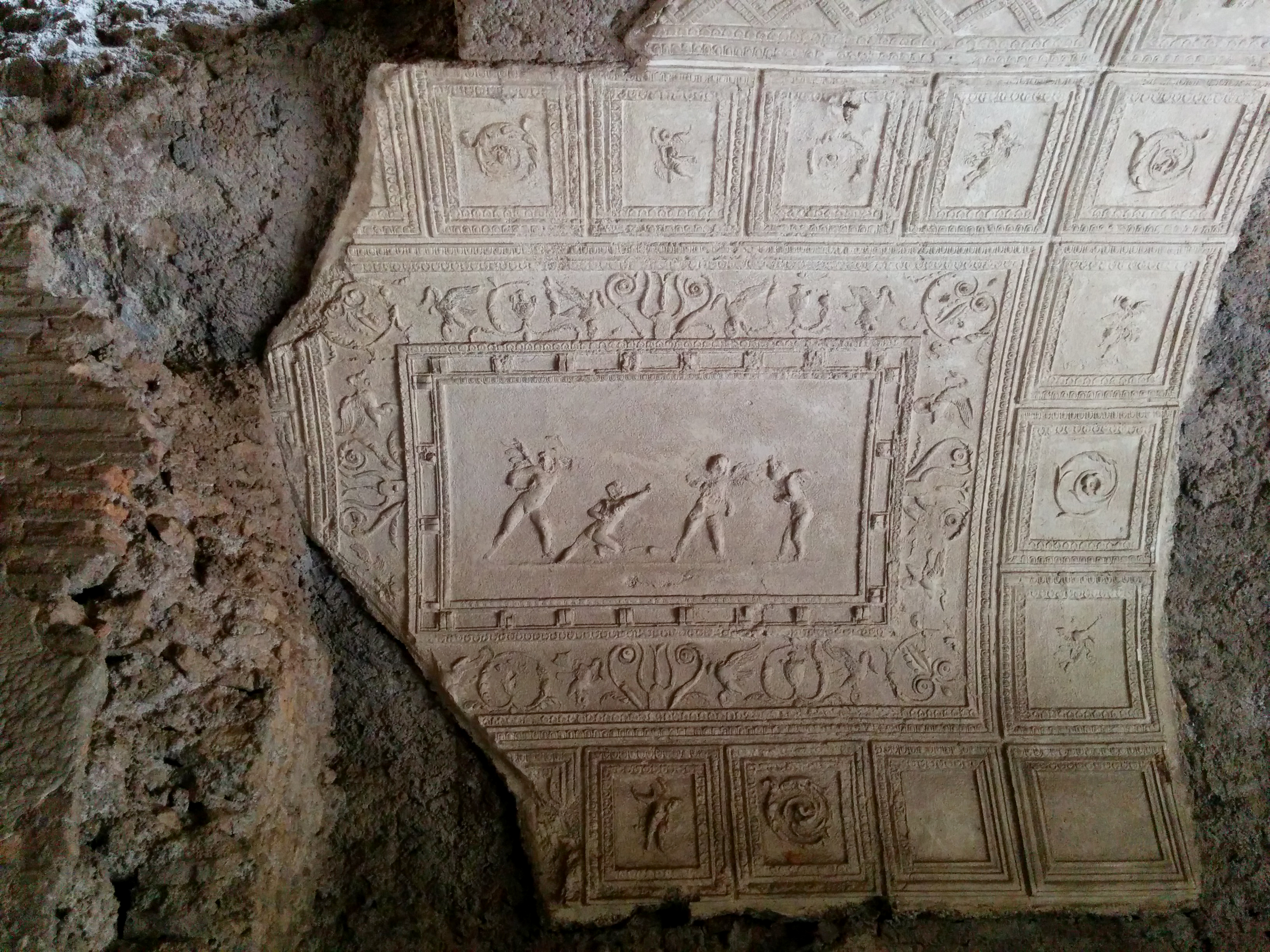Domus Transitoria on:
[Wikipedia]
[Google]
[Amazon]
The Domus Transitoria was Roman emperor
 The palace was intended to connect all of the imperial estates that had been acquired in various ways, with the Palatine including the
The palace was intended to connect all of the imperial estates that had been acquired in various ways, with the Palatine including the

 The main part of the palace was probably on the
The main part of the palace was probably on the
File:Palatine DSCF6828 12.jpg
File:Frammenti di tarsie marmoree dal triclinio della domus transitoria di nerone, 54-64 dc ca. 03.jpg
File:Frammenti di tarsie marmoree dal triclinio della domus transitoria di nerone, 54-64 dc ca., teste 01.jpg, Parts of marble (opus sectile) from the triclinium (Antiquarium)
File:Frammenti di tarsie marmoree dal triclinio della domus transitoria di nerone, 54-64 dc ca. 01.jpg
File:Pannello con opus sectile parietale, età neroniana, dalla domus tiberiana.jpg
File:Frammenti di tarsie marmoree dal triclinio della domus transitoria di nerone, 54-64 dc ca., teste 03.jpg
File:Frammenti di tarsie marmoree dal triclinio della domus transitoria di nerone, 54-64 dc ca., danzatrici 05.jpg, Dancer in marble from the triclinium
Nero
Nero Claudius Caesar Augustus Germanicus ( ; born Lucius Domitius Ahenobarbus; 15 December AD 37 – 9 June AD 68), was the fifth Roman emperor and final emperor of the Julio-Claudian dynasty, reigning from AD 54 un ...
's (r. 54 – 68) first palace damaged or destroyed by the Great Fire of Rome
The Great Fire of Rome ( la, incendium magnum Romae) occurred in July AD 64. The fire began in the merchant shops around Rome's chariot stadium, Circus Maximus, on the night of 19 July. After six days, the fire was brought under control, but befor ...
in 64 AD, and then extended by his Domus Aurea (or Golden House).History
 The palace was intended to connect all of the imperial estates that had been acquired in various ways, with the Palatine including the
The palace was intended to connect all of the imperial estates that had been acquired in various ways, with the Palatine including the Gardens of Maecenas
The Gardens of Maecenas, or ''Horti Maecenatis'', constituted the luxurious ancient Roman estate of Gaius Maecenas, an Augustan-era imperial advisor and patron of the arts. The property was among the first in Italy to emulate the style of Persia ...
, Horti Lamiani
The Horti Lamiani (Lamian Gardens) was a luxurious complex of an ancient Roman villa with large gardens and outdoor rooms located on the Esquiline Hill in Rome, in the area around the present Piazza Vittorio Emanuele. They were created by the con ...
, Horti Lolliani
The Horti Lolliani was a set of private gardens on the Esquiline Hill in ancient Rome, belonging to and named after Lollia Paulina, briefly the wife of Caligula.
After her divorce, Paulina was considered as a potential suitor to the new emperor Cl ...
, etc.
According to Suetonius
Gaius Suetonius Tranquillus (), commonly referred to as Suetonius ( ; c. AD 69 – after AD 122), was a Roman historian who wrote during the early Imperial era
The Roman Empire ( la, Imperium Romanum ; grc-gre, Βασιλεία τ� ...
(Nero 31.1):
"He built a palace extending all the way from the Palatine to the Esquiline, which at first he called the Domus Transitoria, but when it was burned down shortly after its completion and rebuilt, the Golden House".
It was probably built from AD 60.
Layout

Oppian Hill
One of the main buildings is thought to be on the western side of theOppian Hill
The Oppian Hill (Latin, ''Oppius Mons''; it, Colle Oppio) is the southern spur of the Esquiline Hill, one of the Seven hills of Rome, Italy. It is separated from the Cispius on the north by the valley of the Suburra, and from the Caelian H ...
under the Baths of Trajan
The Baths of Trajan ( it, Terme di Traiano) were a massive ''thermae'', a bathing and leisure complex, built in ancient Rome starting from 104 AD and dedicated during the '' kalendae'' of July in 109. Commissioned by Emperor Trajan, the complex of ...
.
The brick walls of the palace were originally covered with marble at the bottom, while the upper parts were frescoed. A portico fronted the domus along the south side. Almost all of the columns, floors and marble walls were removed when Trajan
Trajan ( ; la, Caesar Nerva Traianus; 18 September 539/11 August 117) was Roman emperor from 98 to 117. Officially declared ''optimus princeps'' ("best ruler") by the senate, Trajan is remembered as a successful soldier-emperor who presi ...
built his baths (in 104 AD).
The house was built around a big peristyle
In ancient Greek and Roman architecture, a peristyle (; from Greek ) is a continuous porch formed by a row of columns surrounding the perimeter of a building or a courtyard. Tetrastoön ( grc, τετράστῳον or τετράστοον, lit=f ...
with portico
A portico is a porch leading to the entrance of a building, or extended as a colonnade, with a roof structure over a walkway, supported by columns or enclosed by walls. This idea was widely used in ancient Greece and has influenced many cul ...
s on three sides, while the fourth on the north consisted of a cryptoporticus
In Ancient Roman architecture a cryptoporticus (from atin''crypta'' and '' porticus'') is a covered corridor or passageway. The usual English is "cryptoportico". The cryptoportico is a semi-subterranean gallery whose vaulting supports portico str ...
which supported the rear embankment. At the centre, occupied now by a series of long barrel vaults to support the overlying Trajanic baths are the remains of a fountain; on the eastern part is a large nymphaeum
A ''nymphaeum'' or ''nymphaion'' ( grc, νυμφαῖον), in ancient Greece and Rome, was a monument consecrated to the nymphs, especially those of springs.
These monuments were originally natural grottoes, which tradition assigned as habit ...
that opens to the courtyard.
Nymphaeum of Polyphemus
An elaborate nympheum was unfortunately divided in two by a later wall of Trajan. Surrounded by a portico of four columns it was equipped with a cascading fountain on the bottom, whose water was conveyed into a central basin. On the walls of thegrotto
A grotto is a natural or artificial cave used by humans in both modern times and antiquity, and historically or prehistorically. Naturally occurring grottoes are often small caves near water that are usually flooded or often flooded at high t ...
was a mosaic of which only few traces remain within a frame of shells. The lower part of the walls were originally covered in marble.
The decoration of the vault, high, is preserved only in part where four corner medallions and a central octagon were inserted, the latter partly preserved representing the Polyphemus
Polyphemus (; grc-gre, Πολύφημος, Polyphēmos, ; la, Polyphēmus ) is the one-eyed giant son of Poseidon and Thoosa in Greek mythology, one of the Cyclopes described in Homer's ''Odyssey''. His name means "abounding in songs and ...
scene.
Temple of Venus and Roma
Five metres belowHadrian
Hadrian (; la, Caesar Trâiānus Hadriānus ; 24 January 76 – 10 July 138) was Roman emperor from 117 to 138. He was born in Italica (close to modern Santiponce in Spain), a Roman ''municipium'' founded by Italic settlers in Hispania ...
's Temple of Venus and Roma
The Temple of Venus and Roma ( Latin: ''Templum Veneris et Romae'') is thought to have been the largest temple in Ancient Rome. Located on the Velian Hill, between the eastern edge of the Forum Romanum and the Colosseum, in Rome, it was dedic ...
a sumptuous rotunda belonging to the palace was discovered in 1828, cut through by foundations of the Domus Aurea. The elaborate domed room which interconnected two barrel-vaulted corridors was spectacular architecturally and had marble-lined pools and paving in multicoloured ''opus sectile
''Opus sectile'' is a form of pietra dura popularized in the ancient and medieval Roman world where materials were cut and inlaid into walls and floors to make a picture or pattern. Common materials were marble, mother of pearl, and glass. The ...
'', all still largely intact beneath the temple.
Palatine Hill
 The main part of the palace was probably on the
The main part of the palace was probably on the Palatine Hill
The Palatine Hill (; la, Collis Palatium or Mons Palatinus; it, Palatino ), which relative to the seven hills of Rome is the centremost, is one of the most ancient parts of the city and has been called "the first nucleus of the Roman Empire." ...
and a large and brilliantly decorated set of rooms has been located in the central part of the Palatine Hill
The Palatine Hill (; la, Collis Palatium or Mons Palatinus; it, Palatino ), which relative to the seven hills of Rome is the centremost, is one of the most ancient parts of the city and has been called "the first nucleus of the Roman Empire." ...
under the Palace of Domitian
The Palace of Domitian was built as Roman emperor Domitian's official residence in 81–92 AD and was used as such by subsequent emperors. Its remains sit atop and dominate the Palatine Hill in Rome, alongside other palaces.
The Palace is a massiv ...
. This site was excavated in 1721 when considerable damage was done during the excavations. The lower floors contained sunken gardens, two pavilions, a nymphaeum, and an art gallery. Beyond these rooms is a very large latrine
A latrine is a toilet or an even simpler facility that is used as a toilet within a sanitation system. For example, it can be a communal trench in the earth in a camp to be used as emergency sanitation, a hole in the ground ( pit latrine), or ...
.
In one of these rooms is a rich marble floor found under the oval fountain room of Domitian's Cenatio Iovis, and a rich nymphaeum with marble columns and bronze capitals. Today one corner of the nymphaeum has been rebuilt.
The cryptoporticus
In Ancient Roman architecture a cryptoporticus (from atin''crypta'' and '' porticus'') is a covered corridor or passageway. The usual English is "cryptoportico". The cryptoportico is a semi-subterranean gallery whose vaulting supports portico str ...
of Nero that connected the palace with the nearby Domus Tiberiana
The Domus Tiberiana was an Imperial Roman palace in ancient Rome, located on the northwest corner of the Palatine Hill. It probably takes its name from a house built by the Emperor Tiberius, who is known to have lived on the Palatine, though no ...
was also part of the complex. It is 130 m long with mosaic floors and elaborate stucco ceiling decoration with vegetal elements and cupids. It lies beneath the ''Horti Farnesiani'' along one side of the Domus Tiberiana.
Marble and other parts salvaged from the ruins later became part of the Domus Aurea, Nero's main residence.
Painted ceilings with mythological scenes from the Domus Transitoria, the earliest examples of fourth-style painting, perhaps by the painter Fabullus, are displayed in the Palatine Museum
The Palatine Museum, (, is a museum located on the Palatine Hill in Rome. Founded in the second half of the 19th century, it houses sculptures, fragments of frescoes, and archaeological material discovered on the hill.
History
Pietro Rosa cre ...
.
In 2019 it was announced that this part of the palace will be accessible to the public for the first time in almost 70 years.
Gallery
See also
*List of ancient monuments in Rome
This is a list of ancient monuments from Republican and Imperial periods in the city of Rome, Italy.
Amphitheaters
* Amphitheater of Caligula
* Amphitheatrum Castrense
* Amphitheater of Nero
* Amphitheater of Statilius Taurus
* Colosseum
Ba ...
References
External links
* {{Monuments of Rome Ancient palaces in Rome Ancient Roman buildings and structures in Rome Palatine Hill Rome R. X Campitelli